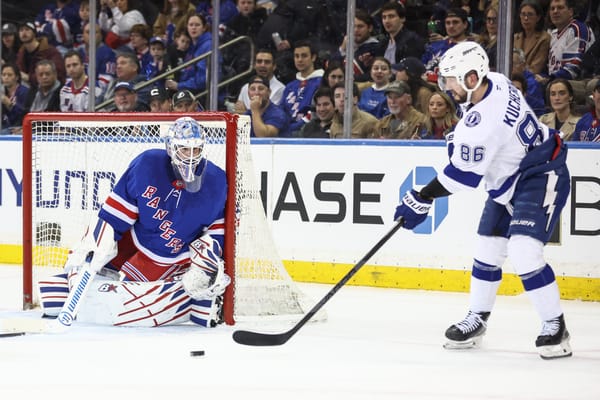2014 Report Card: In Cam Talbot, the Rangers find a reprieve to the throne
For eight seasons, the Rangers struggled to find a consistent backup for Henrik Lundqvist. In year nine, they found an answer in the most unexpected of places.
There isn't one bona fide route to NHL for aspiring hockey players. Just ask Cam Talbot, who finally got his professional break this season as a 26-year-old, undrafted rookie. What's clear now is, Talbot isn't going anywhere.
Birton retires, and a no-name steps up
The Rangers goaltending situation at the beginning of the season was the perfect storm of bad situations. Henrik Lundqvist was playing the worst hockey of his career while trying to negotiate a contract extension on the side. With a nine-game road trip to open the season, and some injuries to key players (including Lundqvist), the anchor that the Rangers' goaltending used to be was headed south, as was New York's record.
Then, Martin Biron gave up nine goals in two appearances on 38 shots against, and retired. It was a nightmare scenario; a doomsday in the blue paint.
So who ya gonna call?
Cam Talbot played his college hockey at the University of Alabama-Huntsville, in an area of the country more known for its football than hockey. The program has a combined record of 209-230-41, or a 0.478 winning percentage. Talbot won 14 times in 70 college appearances.
He went undrafted after his college playing days were over. The Rangers signed Talbot in 2010, and he spent the next three-plus years accumulating AHL experience.
 More on Cam Talbot
More on Cam Talbot 
 More on Cam Talbot
More on Cam Talbot 
Then came the 2013-14 season, and the aforementioned circumstances that set the stage for Talbot to to get a chance to prove himself at the NHL level. And as much as Talbot needed a good showing to solidify his status as an NHL-caliber goalie, the Rangers also needed Talbot with Lundqvist still struggling. And Talbot rose up to the occasion. He gave up 11 goals against in his first eight starts, going 6-1 over that stretch. He showed an overall calm and poise that was hard to predict from someone likely playing for his hockey future. Out of nowhere, if only by accident, the Rangers finally found a reliable, consistent backup to Lundqvist, and another major piece to the puzzle.
Talbot's consistency extended through the end of the regular season. He went 12-6 with a .941 sv%, which would have been tops in the league had he qualified to be a league leader. He posted three shutouts, and only gave up three or more goals three times. In addition to those shutouts, he only allowed one goal in eight additional starts. He was incredibly efficient at stopping pucks, the most important aspect of his job.
Postseason impact
No, this isn't in reference to the two games Talbot came to relieve Lundqvist, but rather, his body of work over the regular season that allowed Lundqvist to rest more during an Olympic year. Undoubtedly, Lundqvist put in one of his stronger if not his best playoff run. It may have just been a coincidence Lundqvist started his second-fewest number of games since his rookie season. Alain Vigneault made it clear he had a target number of games for Talbot to appear in, a plan molded to maximize Lundqvist's postseason efficiency.
In season's past, this wasn't a viable plan. It took the Rangers until mid-December to really find their stride as a team, and they were never really in a position to relax when it came to the standings. And aside from the President's Trophy the team won in 2012, the situation has often been similar. But with backups like Biron, Steve Valiquette, and Kevin Weekes, the weight was squarely on the shoulder's of Lundqvist.
Talbot represented the first backup in Lundqvist's career who was consistent and reliable. He pushed Lunqdvist to be better—something Lundqvist admitted—and provided a new wrinkle to the Rangers goaltending depth.
Grade Talbot's season
| A | 493 |
| B | 108 |
| C | 1 |
| D | 1 |
| F | 0 |
| Didn't see him enough. | 1 |




